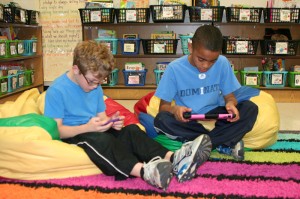-
22
May
I’ve been off the blogging path for a while, sidetracked by a number of projects that I have kept me quite busy for the last 3-4 months. One of those projects was an eTech Ohio Teacher Planning Grant program I have been leading called the Digital Text Initiative. Over the course of the 2011-2012 school year, I’ve been working with 9 K-2 teachers in 3 local districts to study the ways elementary teachers incorporate eBooks in their classroom.
This has been a great project, and one that was noticed by a writer from the New York Times. He published a piece titled “Bringing up an E-Reader” back in March that featured students, parents and a teacher from the DigiTXT program. I’m currently working on data analysis from a variety of sources and also starting to put together some of the greatest hits from the project for the a final report. This report is slated to be released as a white paper about mid-June. I was asked for 3 DOs and 3 DON’Ts for using eBooks that we could use in the white paper. Here they are.
DO:
- Look for eBooks with content that has direct ties to your curriculum and student’s personal experiences.
- Allow students opportunities to self-select eBooks for independent and shared reading experiences.
- Consider the role space plays in the reading experience and design a quality-learning environment for browsing/reading eBooks in the classroom.
DON’T:
- Select eBooks with multimedia or interactivity that is extraneous and/or not relevant to the story.
- Use an eBook with students until you have thoroughly previewed and evaluated its potential as an instructional resource.
- Underestimate the “WOW” factor that eBooks bring to the table. Use their natural engagement to capture reluctant reader’s interest and motivate them.
- Published by brueckj23 in: Raised Digital University of Akron
- If you like this blog please take a second from your precious time and subscribe to my rss feed!


2 Responses to “DOs and DON’Ts for eBooks in Early Learning & Elementary”
As a prep teacher , if there is a print version I prefer to introduce that first, followed by multimedia version. That way have best of both. Lots of discussion about author, setting etc prior to reading. But love the versatility of ebooks, especially when it can be shared on IWB. Animalia has provided many fun learning experiences as we search for different items. Brings different aspect to story.
My preps love that a story can come to life eg Cranky Bear. My role in sharing ebooks still involves oral language, questions etc.
Thanks for sharing, Wendy. You make excellent points about how a teacher can shift their pedagogical approach to maximize the benefits of eBooks in their classroom.
Leave a Reply